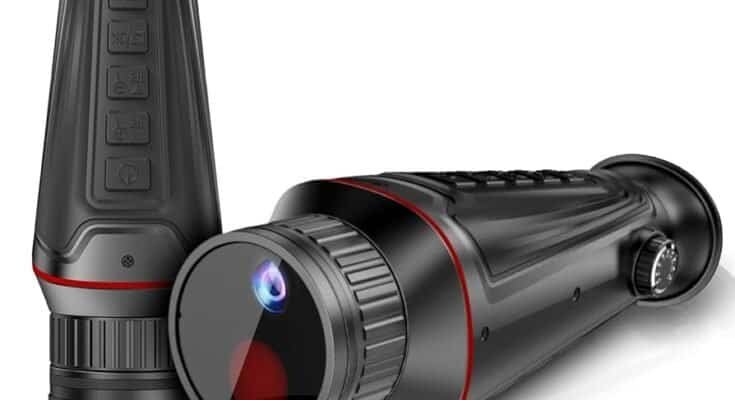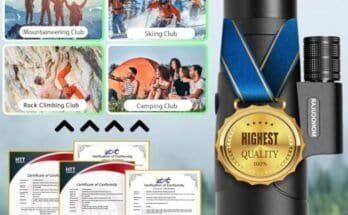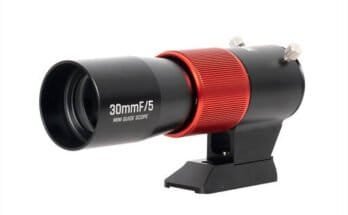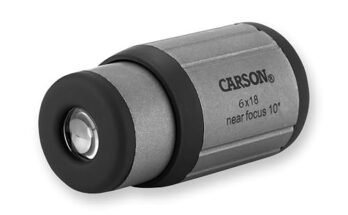If you’ve ever stood in an outdoor store comparing glass, you’ve felt the confusion. What’s the difference between a monocular and binoculars? I’ve tested both in the field for hiking, birding, and night sky sessions. Here’s the simple truth: monoculars are one-eyed, compact spotters for fast, lightweight views, while binoculars use both eyes for a wider, more stable, and more immersive image. Both have a place. The key is matching the tool to your use, your eyes, and your budget. Let’s make that choice easy.

Monocular vs. Binoculars: The Core Differences
Monoculars are half a binocular. You view with one eye. They are lighter, smaller, and faster to carry. They’re great for quick ID at mid-range, reading distant signs, or packing ultralight.
Binoculars use both eyes. That boosts perceived depth, comfort, and detail resolution. With two barrels, you also get a wider field of view and steadier images because your brain blends signals from both eyes.
Key differences you’ll notice in real life:
- Immersion: Binoculars feel natural and 3D. Monoculars feel more “spotter-like.”
- Stability: Two-eye viewing reduces shake and eye strain.
- Size and weight: Monoculars win for pocket carry and ultralight kits.
- Field of view: Binoculars usually show a wider slice of the scene at the same magnification.
- Price vs. performance: A quality monocular can be cheaper than equally sharp binoculars.
From personal use, I reach for a monocular on fast urban walks and travel. For birds, wildlife, and long sessions, binoculars win every time for comfort and detail.
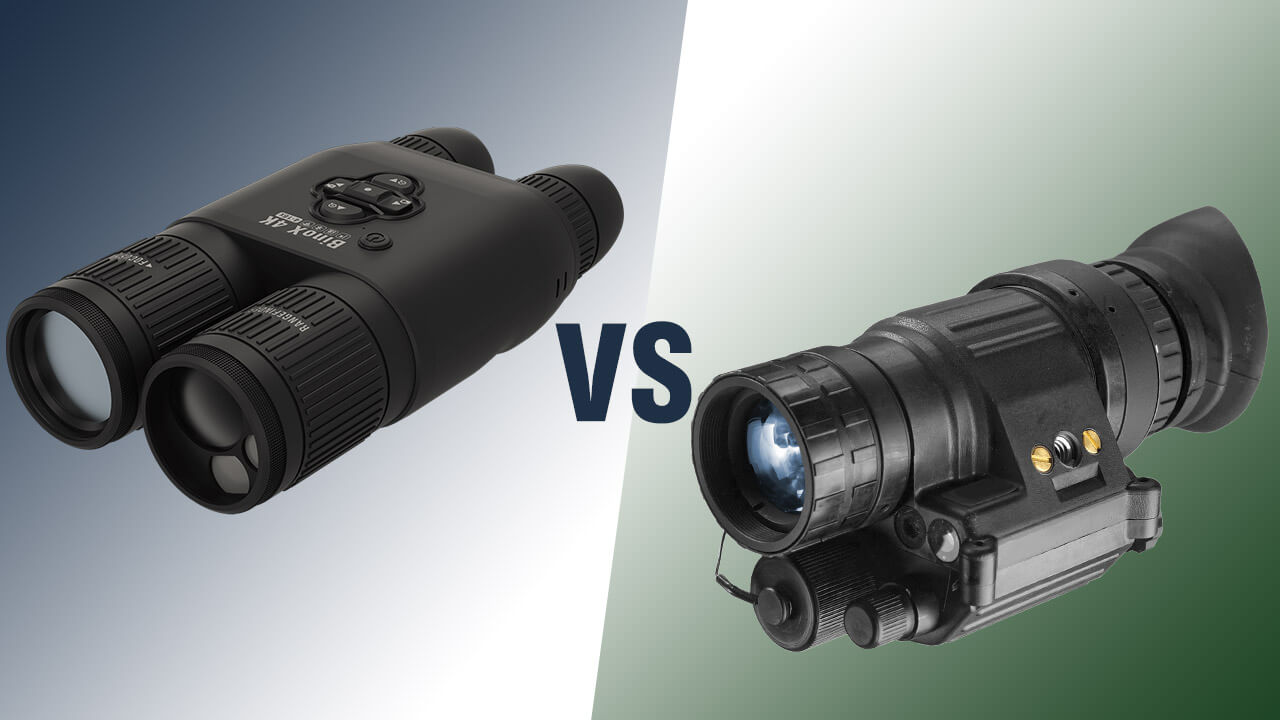
How The Optics Work: Magnification, Field Of View, Exit Pupil, Eye Relief
Every spec tells a story. You’ll often see formats like 8×42 or 10×25.
- Magnification (the “8x” in 8×42): How close the subject looks. Higher isn’t always better. Higher magnification narrows the field of view and amplifies hand shake.
- Objective diameter (the “42” in 8×42): Lens size in millimeters. Bigger lenses collect more light, which helps at dawn, dusk, and for star views.
- Field of view (FOV): Width of the scene at a set distance. Binoculars usually offer a wider FOV than monoculars at the same power, making it easier to find and track subjects.
- Exit pupil: Objective diameter divided by magnification. A larger exit pupil looks brighter in low light and is easier to align to your pupil. Example: 8×42 yields 5.25 mm.
- Eye relief: Distance your eye can be from the eyepiece while seeing the full image. If you wear glasses, look for 15 mm or more.
- Prism type: Roof prisms are sleek and durable. Porro prisms are bulkier but can deliver excellent depth and value.
- Coatings: Fully multi-coated lenses reduce glare and improve contrast. Phase-corrected roof prisms further sharpen details.
Expert note: Using both eyes improves perceived resolution and contrast because the brain fuses images, a phenomenon often called binocular summation. That’s one reason binoculars feel more detailed at the same power.

Use Cases: Which Tool Fits Your Life?
Hiking and ultralight travel:
- Monocular: Ideal. Toss it in a pocket. Great for quick peeks.
- Binoculars: Choose compact 8×25 or 8×32 if you want richer views with minimal weight.
Birding and wildlife:
- Monocular: Works for casual spotting, but tracking fast birds is harder.
- Binoculars: Best choice. 8×42 is a versatile, bright, steady standard.
Sports and events:
- Monocular: Handy and discreet. Good for quick zooms on the action.
- Binoculars: Better comfort for full games or concerts.
Hunting:
- Monocular: Good backup. Useful when every ounce matters.
- Binoculars: Primary glass for scanning, less eye fatigue in long glassing sessions.
Stargazing and low light:
- Monocular: Can work with larger objectives, but one-eye fatigue is real.
- Binoculars: 7×50 or 10×50 feel bright and immersive under the night sky.
Urban use and EDC:
- Monocular: The winner. Simple, small, and fast.
- Binoculars: Choose compacts if you prefer two-eye comfort on city walks.
Pros And Cons At A Glance
Monoculars:
- Pros: Ultra-compact, light, budget-friendly, quick to use one-handed.
- Cons: Narrower field of view, more eye strain over time, less immersive.
Binoculars:
- Pros: Wider views, better depth, less strain, improved detail perception.
- Cons: Bulkier, heavier, often higher cost for similar optical quality.
Real-world lesson: After full-day bird counts, my eyes thank me for choosing 8×42 binoculars. But on a trail run or a carry-on-only trip, I stash a 6x or 8x monocular and never regret the space saved.
How To Choose: Specs That Actually Matter
Pick your magnification:
- 6x to 8x: Easy to hold steady. Best for beginners and moving subjects.
- 10x: More reach, more shake. Consider image stabilization or a tripod mount for longer looks.
Match the objective to your light:
- 25 to 32 mm: Compact, great for daytime use.
- 42 mm: Sweet spot for all-day light and comfort.
- 50 mm and up: Brighter at dusk, but heavier.
Check comfort factors:
- Eye relief: 15 mm or more if you wear glasses.
- Weight and balance: Heavier isn’t always better. Try holding it to see if it steadies well in your hands.
- Focus wheel feel: Smooth focus with a predictable stop helps you nail focus fast.
Optical quality to prioritize:
- Fully multi-coated lenses and phase-corrected roof prisms.
- Good edge-to-edge sharpness and low chromatic aberration.
- Weatherproofing: Waterproof and nitrogen- or argon-purged to prevent fogging.
Pro tip: If your budget is tight, buy slightly lower magnification with better coatings rather than chasing high power with cheap glass. You’ll see more, not less.
Care, Maintenance, And Common Mistakes
Keep lenses clean:
- Use a blower first, then a soft brush, then a microfiber cloth with lens cleaner. Never dry-wipe grit.
Protect from the elements:
- Use caps and a case. Heat and moisture can damage coatings and seals.
Avoid these mistakes:
- Over-magnifying: 12x or 15x handheld sounds great but is often frustrating without stabilization.
- Ignoring eye relief: If you wear glasses, short eye relief means a cropped, tunnel-like view.
- Skipping a test: Hands and faces vary. Always test fit, focus feel, and eye placement.
Field tip: In rain or sea spray, I keep a tiny chamois in a zip bag. It beats smearing moisture with a shirt.
Price, Value, And What To Expect At Each Tier
Entry-level:
- Monoculars: Solid clarity for casual use. Expect basic coatings.
- Binoculars: 8×25 or 8×42 can be decent; watch for dim edges and narrow FOV.
Mid-range:
- Noticeably better coatings, contrast, and low-light performance. Roof-prism binoculars shine here.
Premium:
- Razor-sharp edges, rich contrast, excellent control of glare and color fringing. If you glass daily, premium pays off in comfort and detail.
Note on stabilization:
- Image-stabilized binoculars can outclass higher-power non-stabilized options for steady viewing, but they add cost and weight.
Real-World Scenarios: What I Reach For And Why
- Dawn shorebird survey: 8×42 binoculars. Wide field, bright image, no eye fatigue.
- Trail run or city weekend: 6x or 8x monocular. Pocketable and quick.
- Stadium seats: Compact 8×25 binoculars for comfort through a whole game.
- Mountain glassing: 10×42 binoculars with a chest harness. I carry a lightweight monopod for long looks.
- Night sky on vacation: 10×50 binoculars if I have space; otherwise a 42 mm pair still delights under dark skies.
Lesson learned: The best optic is the one you’ll actually carry. If it stays home, it helps no one.
Frequently Asked Questions Of What’s The Difference Between A Monocular And Binoculars?
Is A Monocular Or Binocular Better For Bird Watching?
Binoculars. The wider field of view and two-eye comfort make tracking birds easier and less tiring, especially at 8x.
Are Monoculars Good For Low Light?
They can be if the objective is large and coatings are good, but binoculars with the same exit pupil usually feel brighter and steadier due to two-eye viewing.
What Magnification Should I Choose?
For most people, 8x is the sweet spot. It balances reach, field of view, and stability. Go 10x only if you can keep it steady or use support.
Do I Need Image Stabilization?
If you want higher power without a tripod, yes. IS binoculars can make 10x to 12x feel much steadier, but they cost more and add weight.
Can I Wear Glasses With These?
Yes. Look for 15 mm or more of eye relief and twist-up eyecups. Test in person if you can to avoid vignetting.
What’s Better For Travel: Monocular Or Binoculars?
For ultralight travel, a monocular is great. For sightseeing and wildlife tours, compact 8×25 or 8×32 binoculars are more immersive.
Are Roof-Prism Or Porro-Prism Binoculars Better?
Roof prisms are slimmer and durable; porros often deliver great depth and value. Quality matters more than prism type alone.
Why Do Binoculars Feel Brighter At The Same Specs?
Two-eye viewing improves perceived brightness and detail due to how your brain fuses images, reducing noise and eye strain.
Conclusion
Monoculars win for speed, size, and simplicity. Binoculars win for comfort, immersion, and detail you can enjoy for hours. If you want a rule of thumb: carry a monocular when every ounce matters, and choose 8x binoculars when the view is the priority. Test for eye relief, field of view, and focus feel before you buy, and invest in coatings and weatherproofing that match your use.
Ready to choose? Start with your main activity, pick a sensible magnification, and get hands-on time if possible. Subscribe for more gear tips, or drop a comment with your use case and budget—I’m happy to help you dial in the perfect glass.
